| Revision as of 23:21, 22 January 2015 editBryce Carmony (talk | contribs)2,039 edits →Launching to Mars: Used Orbital period when I meant synodic period← Previous edit | Revision as of 23:30, 22 January 2015 edit undoBryce Carmony (talk | contribs)2,039 edits →Fictional human missions: Deleted section, very small and there's a great article " mars in fiction" that's in see also. if you miss the section feel free to undoNext edit → | ||
| Line 238: | Line 238: | ||
| Mars analogs are experiments that often use environments that simulate aspects of the conditions people could experience during a hypothetical mission to Mars. These efforts have received major interest by non-governmental organizations interested in spaceflight as well as notable media coverage. | Mars analogs are experiments that often use environments that simulate aspects of the conditions people could experience during a hypothetical mission to Mars. These efforts have received major interest by non-governmental organizations interested in spaceflight as well as notable media coverage. | ||
| ==Fictional human missions== | |||
| The concept of humans travelling to and ] Mars has been explored in books, graphic novels, and movies. Examples include'']'', '']'', and'']''. The latter touches upon ethics of terraforming Mars when it may have ] in the past. | |||
| ==See also== | ==See also== | ||
Revision as of 23:30, 22 January 2015
A human mission to Mars has been the subject of science fiction, engineering, and scientific proposals throughout the 20th century and into the 21st century. The plans comprise proposals to land on Mars, eventually settling on and terraforming the planet, while exploiting its moons, Phobos and Deimos.
Exploration of Mars has been a goal of national space programs for decades. Preliminary work for missions that would involve human explorers has been undertaken since the 1950s, with planned missions typically being cited as taking place 10 to 30 years in the future when they are drafted. The list of manned Mars mission plans in the 20th century shows the various mission proposals that have been put forth by multiple organizations and space agencies in this field of space exploration.
In terms of the current U.S. space program, it has been stated by the publication Bloomberg Businessweek that "much of the hardware that can get humans to Mars already exists and is ready to fly." NASA's long-term program Orion has a projected pace of development such that, as of late 2014, human spaceflight to Mars is anticipated in about 2035. That mission will be preceded by a great deal of shorter flights for the four-person capsule involved, with experiments taking place to better the technologies protecting Mars-bound astronauts from the radiation of deep space.
In fiction, the concept of human visitation of Mars and possible conquest or even transformation of the planet has been explored in numerous books, graphic novels, films, and the like. Examples include the 1990 action film Total Recall, starring Arnold Schwarzenegger, the 2000 science fiction film Red Planet, starring Val Kilmer, and the 2001 horror film Ghosts of Mars, written and directed by John Carpenter. The appeal of space-travel to the planet plays a major role in the many uses of Mars in fiction.
Challenges

There are key challenges for human missions to Mars to overcome:
- Costs of sending people to Mars. Estimated costs have ranged from $6 billion to $500 billion for crewed programs.
- health threats from exposure to high-energy cosmic rays and other ionizing radiation. On 31 May 2013, NASA scientists reported that a possible manned mission to Mars may involve a great radiation risk based on the amount of energetic particle radiation detected by the RAD on the Mars Science Laboratory while traveling from the Earth to Mars in 2011-2012. The calculated radiation dose was 0.66 sieverts round-trip. The agency's career radiation limit for astronauts is 1 sievert.
- Negative effects of a prolonged low-gravity environment on human health, including eyesight loss.
- Psychological effects of isolation from Earth and, by extension, the lack of community due to impossibility of real-time connections with Earth.
- Social effects of several humans living under crowded conditions for more than one Earth year, possibly two or three years, on the mission to Mars, and a comparable length of time on the return to Earth.
- Inaccessibility of terrestrial medical facilities.
- Equipment failure of propulsion or life-support systems.
- Forward contamination of potential habitable zones.
- Back contamination of Earth with possible Martian microbes.
Some of these issues were estimated statistically in the HUMEX study. Ehlmann and others have reviewed political and economic concerns, as well as technological and biological feasibility aspects. While fuel for roundtrip travel could be a challenge, methane and oxygen can be produced using Martian H2O (preferably as water ice instead of liquid water) and atmospheric CO2 with mature technology.
Launching to Mars

The energy need for interplanetary travel is lowest at fixed intervals in the synodic period. For Earth / Mars trips, this is every 26 months (2 years and 2 months), so missions are typically planned to coincide with one of these launch windows. The energy needed in the low-energy windows varies on roughly a 15-year cycle with the easiest windows only need half the energy of the peaks. In the 20th century, there was a minimum in the 1969 and 1971 launch windows and another low in 1986 and 1988, then the cycle repeated.
Several types of mission plans have been proposed, such as the opposition class and conjunction class, or the Crocco flyby. However, typical Mars mission plans have round-trip flight times of 400 to 450 days. A fast Mars mission of 245 days round trip could be possible with on-orbit staging. Using Hohmann transfer orbits is a common plan. In 2014 Ballistic capture was proposed, which may reduce fuel cost and provide more flexible launch windows compared to the Hohmann.
Mission proposals
20th Century
Main article: List of manned Mars mission plans in the 20th centuryOver the last century, a number of mission concepts for such an expedition have been proposed. David Portree's history volume Humans to Mars: Fifty Years of Mission Planning, 1950 - 2000 discusses many of these.
Wernher von Braun proposal (1947 through 1950s)
Wernher von Braun was the first person to make a detailed technical study of a Mars mission. Details were published in his book Das Marsprojekt (1952); published in English as The Mars Project (1962) and several subsequent works, and featured in Collier's magazine in a series of articles beginning March 1952. A variant of the Von Braun mission concept was popularized in English by Willy Ley in the book The Conquest of Space (1949), featuring illustrations by Chesley Bonestell. Von Braun's Mars project envisioned nearly a thousand three-stage vehicles launching from Earth to ferry parts for the Mars mission to be constructed at a space station in Earth orbit. The mission itself featured a fleet of ten spacecraft with a combined crew of 70 heading to Mars, bringing three winged surface excursion ships that would land horizontally on the surface of Mars. (Winged landing was considered possible because at the time of his proposal, the Martian atmosphere was believed to be much denser than was later found to be the case.)
In the 1956 revised vision of the Mars Project plan, published in the book The Exploration of Mars by Wernher Von Braun and Willy Ley, the size of the mission was trimmed, requiring only 400 launches to put together two ships, still carrying a winged landing vehicle. Later versions of the mission proposal, featured in the Disney "Man In Space" film series, showed nuclear-powered ion-propulsion vehicles for the interplanetary cruise.
U.S. proposals (1950s and 1960s)

In 1962, Aeronutronic Ford, General Dynamics and the Lockheed Missiles and Space Company made studies of Mars mission designs as part of NASA Marshall Spaceflight Center "Project EMPIRE". These studies indicated that a Mars mission (possibly including a Venus fly-by) could be done with a launch of eight Saturn V boosters and assembly in low Earth orbit, or possibly with a single launch of a hypothetical "post Saturn" heavy-lift vehicle. Although the EMPIRE missions were only studies, and never proposed as funded projects, these were the first detailed analyses of what it would take to accomplish a human voyage to Mars using data from the actual NASA spaceflight, and laid much of the basis for future studies, including significant mission studies by TRW, North American, Philco, Lockheed, Douglas, and General Dynamics, along with several in-house NASA studies.
Following the success of the Apollo Program, von Braun advocated a manned mission to Mars as a focus for NASA's manned space program. Von Braun's proposal used Saturn V boosters to launch nuclear-powered (NERVA) upper stages that would power two six-crew spacecraft on a dual mission in the early 1980s. The proposal was considered by (then president) Richard Nixon but passed over in favor of the Space Shuttle.
Soviet mission proposals (1956 through 1970)
Main articles: Martian Piloted Complex and TMKThe Martian Piloted Complex or "'MPK'" was a proposal by Mikhail Tikhonravov of the Soviet Union for a manned Mars expedition, using the (then proposed) N-1 rocket, in studies from 1956 to 1962.
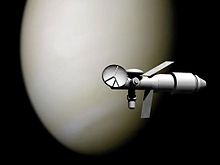
Heavy Interplanetary Spacecraft (known by the Russian acronym TMK) was the designation of a Soviet Union space exploration proposal in the 1960s to send a manned flight to Mars and Venus (TMK-MAVR design) without landing. The TMK spacecraft was due to launch in 1971 and make a three-year long flight including a Mars fly-by at which time probes would have been dropped. The TMK project was planned as an answer from the Soviet Union to the United States manned moon landings. The project was never completed because the required N1 rocket never flew successfully.
The Mars Expeditionary Complex, or "'MEK"' (1969) was another Soviet proposal for a Mars expedition that would take a crew from three to six to Mars and back with a total mission duration of 630 days.
Case for Mars (1981–1996)
Following the Viking missions to Mars, between 1981 and 1996 a series of conferences named The Case for Mars were held at the University of Colorado at Boulder. These conferences advocated human exploration of Mars, presented concepts and technologies, and held a series of workshops to develop a baseline concept for the mission. The baseline concept was notable in that it proposed use of In Situ Resource Utilization to manufacture rocket propellant for the return trip using the resources of Mars. The mission study was published in a series of proceedings volumes published by the American Astronautical Society. Later conferences in the series presented a number of alternative concepts, including the "Mars Direct" concept of Robert Zubrin and David Baker; the "Footsteps to Mars" proposal of Geoffrey A. Landis, which proposed intermediate steps before the landing on Mars, including human missions to Phobos; and the "Great Exploration" proposal from Lawrence Livermore National Laboratory, among others.
NASA Space Exploration Initiative (1989)
Main article: Space Exploration Initiative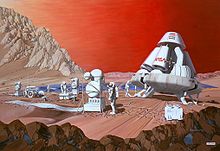
1989 painting by Les Bossinas of Lewis Research Center for NASA
In response to a presidential initiative, NASA made a study of a project for human lunar- and Mars exploration as a proposed follow-on to the International Space Station project. This resulted in a report, called the 90-day study, in which the agency proposed a long-term plan consisting of completing the Space Station as "a critical next step in all our space endeavors," returning to the moon and establishing a permanent base, and then sending astronauts to Mars. This report was widely criticized as too elaborate and expensive, and all funding for human exploration beyond Earth orbit was canceled by Congress.
Mars Direct (early 1990s)
Main article: Mars DirectBecause of the distance between Mars and Earth, the Mars mission would be much more risky and more expensive than past manned flights to the Moon. Supplies and fuel would have to be prepared for a 2-3 year round trip and the spacecraft would have to be designed with at least partial shielding from intense solar radiation. A 1990 paper by Robert Zubrin and David A. Baker, then of Martin Marietta, proposed reducing the mission mass (and hence the cost) with a mission design using In Situ Resource Utilization to manufacture propellant from the Martian Atmosphere. This proposal drew on a number of concepts developed by the former "Case for Mars" conference series. Over the next decade, this proposal was developed by Zubrin into a mission concept, Mars Direct, which he developed in a book, The Case for Mars (1996). The mission is advocated by the Mars Society, which Zubrin founded in 1998, as a practical and affordable plan for a manned Mars mission.
International Space University (1991)
In 1991 in Toulouse, France, the International Space University studied an international human Mars mission. They proposed a crew of 8 traveling to Mars in a nuclear-powered vessel with artificial gravity provided by rotation. On the surface, 40 tonne habitats pressurized to 10 psi were powered by a 40 kW photovoltaic array.
NASA Design reference missions (1990s)
Main article: Design reference mission 3.0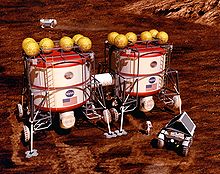
In the 1990s NASA developed several conceptual level human Mars exploration architectures. One of these was NASA Design reference mission 3.0 (DRM 3.0). It was a study performed by the NASA Mars Exploration Team at the NASA's Johnson Space Center (JSC) in the 1990s. Personnel representing several NASA field centers formulated a "Reference Mission" addressing human exploration of Mars. The plan describes a human mission to Mars with concepts of operations and technologies to be used as a first cut at an architecture. The architecture for the Mars Reference Mission builds on previous work, principally on the work of the Synthesis Group (1991) and Zubrin's (1991) concepts for the use of propellants derived from the Martian atmosphere. The primary purpose of the Reference Mission was to stimulate further thought and development of alternative approaches, which can improve effectiveness, reduce risks, and reduce cost. Improvements can be made at several levels; for example, in the architectural, mission, and system levels.
Selected other US/NASA plans (1988–2009):
- 1) 1988 "Mars Expedition"
- 2) 1989 "Mars Evolution"
- 3) 1990 "90-Day Study"
- 4) 1991 "Synthesis Group"
- 5) 1995 "DRM 1"
- 6) 1997 "DRM 3"
- 7) 1998 "DRM 4"
- 8) 1999 "Dual Landers"
21st Century
NASA Design reference missions (2000+)
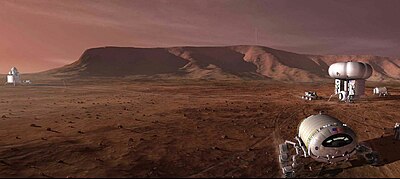
Development of reference missions continued in the 21st century Selected other US/NASA plans (1988–2009):
- 11) 2000 SERT (SSP)
- 12) 2002 NEP Art. Gravity
- 13) 2001 DPT/NEXT
- 14) 2009 DRA 5
MARPOST (2000/2005)
The Mars Piloted Orbital Station (or MARPOST) is a Russian proposed manned orbital mission to Mars, using a nuclear reactor to run an electric rocket engine. Proposed in October 2000 by Yuri Karash from the Russian Academy of Cosmonautics as the next step for Russia in space along with the Russian participation in the International Space Station, a 30-volume draft project for MARPOST has been confirmed as of 2005. Design for the ship proposed to be ready in 2012, and the ship itself in 2021.
ESA Aurora programme (2001+)
Main article: Aurora programmeThe European Space Agency had a long-term vision of sending a human mission to Mars in 2033. Laid out in 2001, the project's proposed timeline would begin with robotic exploration, a proof of concept simulation of sustaining humans on Mars, and eventually a manned mission; however, objections from the participating nations of ESA and other delays have put the timeline into question.
ESA/Russia plan (2002)
Another proposal for a joint ESA mission with Russia is based on two spacecraft being sent to Mars, one carrying a six-person crew and the other the expedition's supplies. The mission would take about 440 days to complete with three astronauts visiting the surface of the planet for a period of two months. The entire project would cost $20 billion and Russia would contribute 30% of these funds.
USA Vision for Space Exploration (2004)
Main article: Vision for Space Exploration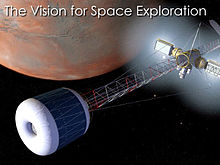
Project Constellation included an Orion Mars Mission. United States President George W. Bush announced an initiative of manned space exploration on January 14, 2004, known as the Vision for Space Exploration. It included developing preliminary plans for a lunar outpost by 2012 and establishing an outpost by 2020. Precursor missions that would help develop the needed technology during the 2010-2020 decade were tentatively outlined by Adringa and others. On September 24, 2007, Michael Griffin, then NASA Administrator, hinted that NASA may be able to launch a human mission to Mars by 2037. The needed funds were to be generated by diverting $11 billion from space science missions to the vision for human exploration.
NASA has also discussed plans to launch Mars missions from the Moon to reduce traveling costs.
Mars Society Germany - European Mars Mission (EMM) (2005)
The Mars Society Germany proposed a manned Mars mission using several launches of an improved heavy-lift version of the Ariane 5. Roughly 5 launches would be required to send a crew of 5 on a 1200 days mission, with a payload of 120,000 kg (260,000 lb).
China National Space Administration (CNSA) (2006)
Main article: Chinese space program § Mission to Mars and beyondSun Laiyan, administrator of the China National Space Administration, said on July 20, 2006 that China would start deep space exploration focusing on Mars over the next five years, during the Eleventh Five-Year Plan (2006–2010) Program period. The first uncrewed Mars exploration program could take place between 2014–2033, followed by a crewed phase in 2040-2060 in which crew members would land on Mars and return home. The Mars 500 study of 2011 prepared for this manned mission.
The One-Way Trip Option (2006); Mars to Stay (2006)
Main article: Mars to StayThe idea of a one-way trip to Mars has been proposed several times. Space activist Bruce Mackenzie, for example, proposed a one-way trip to Mars in a presentation "One Way to Mars - a Permanent Settlement on the First Mission" at the 1998 International Space Development Conference, arguing that since the mission could be done with less difficulty and expense if the astronauts were not required to return to Earth, the first mission to Mars should be a settlement, not a visit. In 2006, former NASA engineer James C. McLane III proposed a scheme to initially colonize Mars via a one way trip by only one human. Papers discussing this concept appeared in The Space Review, Harper's Magazine, SEARCH Magazine and The New York Times.
Mars to Stay proposes that astronauts sent to Mars for the first time should stay there indefinitely, both to reduce mission cost and to ensure permanent settlement of Mars. Among many notable Mars to Stay advocates, former Apollo astronaut Buzz Aldrin is a particularly outspoken promoter who has suggested in numerous forums "Forget the Moon, Let's Head to Mars!" In June 2013, Aldrin wrote an opinion published in The New York Times supporting a manned mission to Mars and views the moon "not as a destination but more a point of departure, one that places humankind on a trajectory to homestead Mars and become a two-planet species."
NASA Design Reference Mission 5.0 (2007)
NASA released initial details of the latest version conceptual level human Mars exploration architecture in this presentation. The study further developed concepts developed in previous NASA DRM and updated it to more current launchers and technology.
MarsDrive mission design (2008)
The MarsDrive Organization has been working at a series of new human mission designs starting with Mars for Less. Their current design program under Director of Engineering Ron Cordes has discarded many of the Mars for Less elements and was reviewed as MarsDrive DRM 2.5 in June 2008. Some of their design philosophy is focused on using current or near term existing launch vehicle systems, permanent human settlement, conceptual EDL systems and enhanced surface ISRU. Their current design in 2012 is titled "Ready For Mars" and focuses on use of small Viking heritage landers to solve the Entry, Descent and Landing challenge. Their proposed methods of funding the mission are also an alternative to the current government funded plans with a private consortium approach being investigated.
NASA Design Reference Mission Architecture 5.0 (2009)
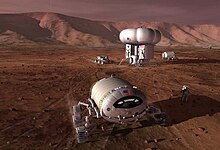
NASA released an updated version of NASA DRM 5.0 in early 2009, featuring use of the Ares V launcher, Orion CEV, and updated mission planning. In this document.
NASA Austere Human Missions to Mars (2009)
Extrapolated from the DRMA 5.0, plans for a manned Mars expedition with chemical propulsion. Austere Human Missions to Mars
USA's Mars orbit by the mid-2030s (2010)
In a major space policy speech at Kennedy Space Center on April 15, 2010, U.S. President Barack Obama predicted a manned Mars mission to orbit the planet by the mid-2030s, followed by a landing:
By the mid-2030s, I believe we can send humans to orbit Mars and return them safely to Earth. And a landing on Mars will follow. And I expect to be around to see it.
The United States Congress has mostly approved a new direction for NASA that includes canceling Bush's planned return to the Moon by 2020 and instead proposes asteroid exploration in 2025 and orbiting Mars in the 2030s.
Russian mission proposals (2011)
A number of Mars mission concepts and proposals have been put forth by Russian scientists. Stated dates were for a launch sometime between 2016 and 2020. The Mars probe would carry a crew of four to five cosmonauts, who would spend close to two years in space.
In late 2011, Russian and European space agencies successfully completed the ground-based MARS-500. The biomedical experiment simulating manned flight to Mars was completed in Russia in July 2000.
2-4-2 concept (2011-2012)
In 2011, Jean-Marc Salotti published a new proposal for a manned Mars mission, with a release in 2012. The 2-4-2 concept is based on a reduction of the crew size to only 2 astronauts and the duplication of the entire mission. There are 2 astronauts in each space vehicle, there are 4 on the surface of Mars and there are 2 once again in each return vehicle. In addition, at every step of the mission, there are 2 astronauts ready to help the 2 others (2 for 2). This architecture simplifies the entry, descent and landing procedures, which are known to be very risky, thanks to a significant reduction of the size of the landing vehicles. It also avoids the assembly of huge vehicles in LEO. The author claims that his proposal is much cheaper than the NASA reference mission without compromising the risks and can be undertaken before 2030.
NASA/SpaceX 'Red Dragon' (2012)
Main article: Red Dragon (spacecraft)Red Dragon is a proposed concept for a low-cost Mars lander mission that would use a SpaceX Falcon Heavy launch vehicle, and a modified Dragon capsule to enter the Martian atmosphere. The concept was slated to be proposed for funding in 2012/2013 as a NASA Discovery mission, for launch in 2018. However, it was never proposed for that funding. The primary objective would be the search for evidence of life on Mars (biosignatures), past or present; a substantially unmodified version of the crewed Dragon capsule could be used for payload transport to Mars, and would be a precursor to the ambitious long-term plans of a manned mission to Mars.
Conceptual Space Vehicle Architecture for Human Exploration of Mars (2012)
In 2012, Conceptual Space Vehicle Architecture for Human Exploration of Mars, with Artificial Gravity and Mini-Magnetosphere Crew Radiation Shield was released, outlaying a possible design for a human Mars mission. Components of the architecture include various spacecraft for the Earth-to-Mars journey, landing, and surface stay as well as return. Some features include a several unmanned cargo landers assembled into a base on the surface of Mars. The crew would land at this base in the "Mars Personnel Lander", which could also take them back into Mars orbit. The design for the manned interplanetary spacecraft included artificial-gravity and an artificial magnetic field. Overall, the architecture was modular and to allow for incremental R&D.
Mars One (2012)
Main article: Mars OneIn 2012, a Dutch entrepreneur group revealed plans of a fund-raising campaign for a human Mars base to begin in 2023. One difference from other projects is that 'Mars One' is organized as a not-for-profit organization, strives to use worldwide suppliers, with no politics involved. It would be a "one-way" mission, i.e., there will be no return trip to Earth. Astronaut applications are invited from the public all over the world.
In 2018, a telecom orbiter would be sent, a rover in 2020, and after that the base components and its settlers. The base would be powered by 3,000 square meters of solar panels. The SpaceX Heavy rocket would launch flight hardware. The first crew of 4 astronauts would land on Mars in 2025. Then, every two years, a new crew of 4 astronauts would arrive. Current plans specify that the entire mission is to be filmed and broadcast back to Earth as a media event, revenues from which would help fund the program.
The Mars Initiative (2013)
Main article: The Mars InitiativeThis is a publicly funded international non-profit organization focused on space advocacy, space exploration, and the promotion of a human mission to Mars including exploration of Mars and the colonization of Mars.

Inspiration Mars Foundation (2013)
Main article: Inspiration Mars FoundationIn 2013, the Inspiration Mars Foundation founded by Dennis Tito plans a manned mission to fly by Mars in 2018.
Current intentions
A number of nations and organisations have long-term intentions to send humans to Mars.


- The United States has a number of robotic missions currently exploring Mars, with a sample-return planned for the future. On December 5, 2014 NASA successfully launched and tested the Orion Multi-Purpose Crew Vehicle (MPCV), the first component of NASA's planned Mars mission program. The Orion MPCV will serve as the launch/ splashdown crew delivery vehicle, in combination with a Deep Space Habitat module, which will provide additional living-space for the crew on the 16 month long journey from Earth to Mars and back. The first manned Mars Mission, which will include sending astronauts to Mars, orbiting Mars, and a return to Earth, is currently scheduled for the 2030s. One possible means of propulsion for such interplanetary transport ships has been proposed by New Scientist. In its proposal, New Scientist outlines an argon plasma-based VASIMR rocket which the group claims could reduce the interplanetary transit time to less than 40 days. As a training venue for future Mars missions, NASA has used the Haughton impact crater on Devon Island due to the crater's similarity with Martian geology.
- The European Space Agency has sent robotic probes, and has long-term plans to send humans but has not yet built a manned spacecraft. It plans to launch an unmanned mission to Mars, ExoMars, in 2016.
- Russia (and previously the Soviet Union) has sent a large number of probes. It can send humans into Earth orbit and has extensive experience with long-term manned orbital space flight due to its space station programs. A simulation of a manned Mars mission, called Mars-500, was completed in Russia in November 2011.
- India successfully placed an unmanned Mars Orbiter Mission (also called Mangalyaan) satellite in Mars orbit on 23 September 2014.
- Japan has sent one robotic mission to Mars, the Nozomi, but it failed to achieve Mars orbit.
- China's mission to Mars, the Yinghuo-1 space probe, was lost with Russia's sample return mission to Phobos, Fobos-Grunt.
Technological innovations and hurdles

Various technologies may aid a human mission to Mars.
One of the medical supplies that may be needed is intravenous fluid, which is mostly water but contains other things so it can be added directly to the human blood stream. If it can be created on the spot from existing water then it could spare the weight of hauling earth-produced units, whose weight is mostly water. A prototype for this capability was tested on the International Space Station in 2010.
While it is possible for humans to breathe pure oxygen, a pure oxygen atmosphere was implicated in the Apollo 1 fire. As such, Mars habitats may have a need for additional gases. One possibility is to take nitrogen and argon from the atmosphere of Mars; however, they are hard to separate from each other. As a result, a Mars habitat may use 40% argon, 40% nitrogen, and 20% oxygen.
Precursor missions
Mars sample return missions
| This section needs expansion. You can help by adding to it. (June 2013) |

An unmanned Mars sample return mission (MSR) is often considered to be an essential precursor to crewed missions to Mars' surface.
Crewed orbital missions
Landis and Lupisella proposed to explore Mars via telepresence from human astronauts in orbit.
A similar idea, was the proposed "Human Exploration using Real-time Robotic Operations" (HERRO) mission.
Another proposed mission was the Russian Mars Piloted Orbital Station.
Lockheed Martin as part of their "Stepping stones to Mars" project, called the "Red Rocks Project" proposed to explore Mars robotically from Deimos.
Mars analogs

| This section needs expansion. You can help by adding to it. (June 2013) |
Mars analogs are experiments that often use environments that simulate aspects of the conditions people could experience during a hypothetical mission to Mars. These efforts have received major interest by non-governmental organizations interested in spaceflight as well as notable media coverage.
See also
3References
- Bachman, Justin (December 2, 2014). "NASA Is Launching a Spacecraft That Will Take Humans to Mars". Bloomberg Businessweek. Retrieved January 6, 2014.
{{cite news}}: Italic or bold markup not allowed in:|publisher=(help) - ^ Kerr, Richard (31 May 2013). "Radiation Will Make Astronauts' Trip to Mars Even Riskier". Science. 340 (6136): 1031. doi:10.1126/science.340.6136.1031. Retrieved 31 May 2013.
- ^ "Measurements of Energetic Particle Radiation in Transit to Mars on the Mars Science Laboratory". Science. 340 (6136): 1080–1084. 31 May 2013. doi:10.1126/science.1235989. Retrieved 31 May 2013.
{{cite journal}}: Unknown parameter|authors=ignored (help) - ^ Chang, Kenneth (30 May 2013). "Data Point to Radiation Risk for Travelers to Mars". New York Times. Retrieved 31 May 2013.
- Mission to Mars: Reality check @ NBCNEWS
- Mars: the Red-Tape Planet?
- The Space Review
- Saganti, P. B. et al. (2006)
- Shiga, David (2009-09-16), "Too much radiation for astronauts to make it to Mars", New Scientist (2726)
- Fong, MD, Kevin (12 February 2014). "The Strange, Deadly Effects Mars Would Have on Your Body". Wired (magazine). Retrieved 12 February 2014.
- Gelling, Cristy (June 29, 2013). "Mars trip would deliver big radiation dose; Curiosity instrument confirms expectation of major exposures". Science News. 183 (13): 8. Retrieved July 8, 2013.
- Mader, T. H.; et al. (2011). "Optic Disc Edema, Globe Flattening, Choroidal Folds, and Hyperopic Shifts Observed in Astronauts after Long-duration Space Flight". Ophthalmology (journal). 118 (10): 2058–2069. doi:10.1016/j.ophtha.2011.06.021. PMID 21849212.
{{cite journal}}: Explicit use of et al. in:|author=(help) - Puiu, Tibi (November 9, 2011). "Astronauts' vision severely affected during long space missions". zmescience.com. Retrieved February 9, 2012.
- News (CNN-TV, 02/09/2012) - Video (02:14) - Male Astronauts Return With Eye Problems
- COSPAR AND NASA POLICIES
- Horneck and Comet (2006), doi:10.1016/j.asr.2005.06.077
- Ehlmann, B. L., et al. (2005), doi:10.1016/j.actaastro.2005.01.010
- Rapp et al. (2005) doi:10.1109/AERO.2005.1559325
- ^ David S. F. Portree, Humans to Mars: Fifty Years of Mission Planning, 1950 - 2000, NASA Monographs in Aerospace History Series, Number 21, February 2001. Available as NASA SP-2001-4521.
- ^ Page 18-19 in Chapter 3 of David S. F. Portree's Humans to Mars: Fifty Years of Mission Planning, 1950 - 2000, NASA Monographs in Aerospace History Series, Number 21, February 2001. Available as NASA SP-2001-4521.
- Page 15-16 in Chapter 3 of David S. F. Portree's Humans to Mars: Fifty Years of Mission Planning, 1950 - 2000, NASA Monographs in Aerospace History Series, Number 21, February 2001. Available as NASA SP-2001-4521.
- Dr. Von Braun - When will we land on Mars? - Mar 1965 - Page 86
- Folta, et al. - FAST MARS TRANSFERS THROUGH ON-ORBIT STAGING. (2012)
- Making A Trip To Mars Cheaper & Easier: The Case For Ballistic Capture
- ^ Annie Platoff, Eyes on the Red Planet: Human Mars Mission Planning, 1952-1970, (1999); available as NASA/CR-2001-2089280 (July 2001)
- Wernher von Braun, The Mars Project, University of Illinois Press, Urbana, IL, 1962
- Wernher von Braun, "The Next 20 Years of Interplanetary Exploration," Astronautics & Aeronautics, November 1965, pp 24-34.
- M. Wade, Von Braun Mars Expedition - 1952, in Encyclopedia Astronautica
- Von Braun Mars Expedition - 1956, in Encyclopedia Astronautica
- "The Disney-Von Braun Collaboration and Its Influence on Space Exploration" by Mike Wright
- Franklin Dixon, "Summary Presentation: Study of a Manned Mars Excursion Module," in Proceeding of the Symposium on Manned Planetary Missions: 1963/1964 Status, NASA TM X-53049 (1964).
- Wernher von Braun, "Manned Mars Landing Presentation to the Space Task Group," presentation materials, August 1969 (referenced by Portree, 2001 op cit.
- Penelope J. Boston, ed., AAS Science and Technology Series Volume 57, Proceedings of The Case for Mars I, 1984 (second printing 1987), ISBN 0-87703-197-5
- Christopher P. McKay, ed., AAS Science and Technology Series Volume 62, Proceedings of The Case for Mars II, 1985 (second printing 1988) 730p. Hard cover: ISBN 0-87703-219-X, Soft cover: ISBN 0-87703-220-3.
- ^ Geoffrey A. Landis, "Footsteps to Mars: an Incremental Approach to Mars Exploration," Journal of the British Interplanetary Society, Vol. 48, pp. 367-342 (1995); presented at Case for Mars V, Boulder CO, 26–29 May 1993; appears in From Imagination to Reality: Mars Exploration Studies, R. Zubrin, ed., AAS Science and Technology Series Volume 91 pp. 339-350 (1997). (text available as Footsteps to Mars pdf file
- NASA, Report of the 90-day study on human exploration of the Moon and Mars, published 11/1989; abstract
- Dwayne Day, "Aiming for Mars, grounded on Earth," The Space Review February 16, 2004 link
- R. M. Zubrin, D. A. Baker and O. Gwynne, "Mars Direct: A Simple, Robust, and Cost Effective Architecture for the Space Exploration Initiative," paper AAS 90-168, in The Case for Mars IV: The International Exploration of Mars, Part I, MISSION STRATEGY & ARCHITECTURES, AAS Science and Technology Series Volume 89, Proceedings of The Case for Mars Conference, ed. Thomas R. Meyer, 1997 (ISBN 0-87703-418-4).
- R. Zubrin and D. A. Baker, "Mars Direct: Humans to the Red Planet by 1999," 41st Congress of the International Astronautical Federation (1990)
- ^ Wendell W. Mendell - A Mission Design for International Manned Mars Mission (1991)
- ^ NASA Austere Human Missions to Mars (2009)
- Yury Zaitsev (30 March 2005). "Russia Suggests Manned Martian-Mission Plan". Rianovosty.
- Vladimir Isachenkov (29 October 2009). "Russia Hopes To Fly Humans To Mars With Nuclear Spaceship". The Huffington Post.
- Fred Guterl (2005-11-22). "The Race to Mars". Discover Magazine. Retrieved 2012-08-16.
- "Russia proposes manned Mars mission by 2015" - 8 July 2002 - New Scientist
- NASA - Lunar Outpost Plans Taking Shape
- Adringa, J. M. et al. (2005), doi:10.1109/AERO.2005.1559312
- AFP: NASA aims to put man on Mars by 2037
- President Bush Announces New Vision for Space Exploration Program
- The Space Age at 50. National Geographic Magazine, October 2007 issue
- ^ http://www.astronautix.com/craft/eurssion.htm
- People's Daily Online - Roundup: China to develop deep space exploration in five years
- 中国嫦娥探月工程进展顺利 进度将有望加快-军事频道-中华网-中国最大职业人士门户
- Bruce Mackenzie,One Way to Mars - a Permanent Settlement on the First Mission," presented at the 1998 International Space Development Conference, May 21–25, Milwaukee WI; Abstract
- James C. McLane III, "Spirit of the Lone Eagle": an audacious program for a manned Mars landing, The Space Review July 31, 2006 link
- James C. McLane III, "Starship Trooper," Harper's Magazine November 2006. link (pay subscription required)
- James C. McLane III, "One Way Ticket to Mars," SEARCH Magazine Jan/Feb 2009 link to archived copy
- Krauss, Lawrence M. (31 August 2009). "A One-Way Ticket to Mars". New York Times. Retrieved 2011-07-20.
- Buzz Aldrin Speaks Out: Forget the Moon, Let's Head to Mars, by Eliza Strickland, 26 June 2006, Discover Magazine
- Aldrin, Buzz (13 June 2013). "The Call of Mars". New York Times. Retrieved 17 June 2013.
- Version 5 NASA (jan. 2009)
- Congress Mostly Approves New Direction for NASA. Yudhijit Bhattacharjee, 30 September 2010, Science.
- Mars-500 crew report good health after experiment - RIAN
- Russian Spacecraft: Manned Martian Expedition
- Jean-Marc Salotti, Acta Astronautica, Volume 69, Issues 5–6, September–October 2011, Pages 266–279.
- Jean-Marc Salotti, Acta Astronautica, Volume 81, Issue 1, December 2012.
- ^ Wall, Mike (2011-07-31). "'Red Dragon' Mission Mulled as Cheap Search for Mars Life". SPACE.com. Retrieved 2012-05-01.
- ^ "NASA ADVISORY COUNCIL (NAC) - Science Committee Report" (PDF). Ames Research Center, NASA. 1 November 2011. Retrieved 2012-05-01.
- ^
- ^ A. Strange - Dutch Group Planning for Mars Settlement by 2025 (June 2012) - PC MAG
- Mars One - Is this really possible?
- Anne Sewell (2 Jan 2013). "The Mars Initiative: A public fund for a human mission to Mars". Digital Journal. Retrieved 6 Jan 2013.
- Space Tourist to Announce Daring Manned Mars Voyage for 2018
- http://thespacereporter.com/2013/02/millionaire-space-tourist-planning-historic-journey-to-mars-in-2018/
- "Nasa's Orion spacecraft prepares for launch in first step towards manned Mars mission". Washington Post. Retrieved 2014-12-03.
- "Twitter feed of NASA". Twitter. Retrieved 2014-12-02.
- "NASA's Orion Flight Test and the Journey to Mars". NASA website. Retrieved 2014-12-01.
- Grossman, Lisa. "Ion engine could one day power 39-day trips to Mars". New Scientist. Retrieved 2009-07-31.
- Mars on Earth. National Geographic Magazine, February 2001 issue
- "India celebrates Mars mission 'cheaper than a movie'". Telegraph.co.uk. Retrieved 24 September 2014.
- S86-25375 (1986)
- ^ A Solution for Medical Needs and Cramped Quarters in Space - NASA
- ^ D. Murphy - Martian Air Breathing Mice (archived website)
- G.A. Landis, "Teleoperation from Mars Orbit: A Proposal for Human Exploration," Acta Astronautica, Vol. 61, No. 1, pp 59-65; presented as paper IAC-04-IAA.3.7.2.05, 55th International Astronautical Federation Congress, Vancouver BC, Oct. 4-8 2004.
- M. L. Lupisella, "Human Mars Mission Contamination Issues", Science and the Human Exploration of Mars, January 11–12, 2001, NASA Goddard Space Flight Center, Greenbelt, MD. LPI Contribution No. 1089. (accessed 11/15/2012)
- George R. Schmidt, Geoffrey A. Landis, and Steven R. Oleson NASA Glenn Research Center, Cleveland, Ohio, 44135 HERRO Missions to Mars and Venus using Telerobotic Surface Exploration from Orbit 48th AIAA Aerospace Sciences Meeting Including the New Horizons Forum and Aerospace Exposition 4–7 January 2010, Orlando, Florida
- HERRO TeleRobotic Exploration of Mars, Geoffrey Landis, Mars Society 2010 4 part YouTube Video
- Larry Page Deep Space Exploration - Stepping Stones builds up to "Red Rocks : Explore Mars from Deimos"
- One Possible Small Step Toward Mars Landing: A Martian Moon
External links
- Human Exploration of Mars: The Reference Mission Design Reference Mission 1.0
- Reference Mission Version 3.0, Addedum to Human Exploration of Mars Design Reference Mission 3.0
- Mars Expeditions & Flybys & Selected Flybys List of most manned mission projects to Mars
- a longer bibliography can be found in the bibliography of Portree's book, available in pdf format from NASA.
Lua error in Module:Navbox at line 535: attempt to get length of local 'arg' (a number value). Lua error in Module:Navbox at line 535: attempt to get length of local 'arg' (a number value). Lua error in Module:Navbox at line 535: attempt to get length of local 'arg' (a number value).
Categories: